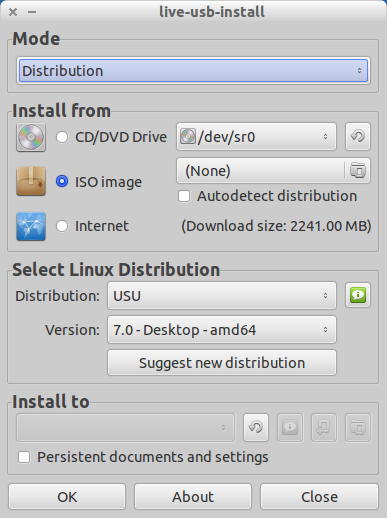

- #Ubuntu usb installer maker install
- #Ubuntu usb installer maker update
- #Ubuntu usb installer maker driver
- #Ubuntu usb installer maker portable
There was a suggestion to install (or just boot) linux, to see if the mouse is still disconnecting, trying to prove if it's a hardware or a macOS problem. There's a long discussion on MacRumors at, and I pretty much documented all the troubleshooting I have done trying to get to the bottom of it.

The Magic Mouse 2 I am trying to use with it constantly disconnects. The reason I tried was because I am having a nasty issue with my MBP. Thank you for the prompt response! :-) It's not like I want to run linux on my MBP as a substitute to macOS, although it would be fun to see it once.

Maybe somebody of you has an idea what I can try to install the OS again? I switched harddrives, tried different drive slots within the Mac Pro, different USB Sticks for startup - so to speak I have absolutely no more ideas to figure out what's the issue with that Mac. The issue now is, that I can select the USB Stick from the boot menu, but as soon as I hit ENTER, only a gram screen appears and nothing happens. After preparing a macOS elCapitan installation USB-Drive, I tried to re-install the OS via booting from USB stick. Due to that I completely formatted the entire hard drive with an external SATA adaptor via my MacBook and plugged it back into the Mac Pro. Somehow the old macOS 10.6 recovery (it's snow leopard I think) was additionally installed on the disk. Form there on I tried the recovery mode a thousand times to re-install the elCapitan OS again.
#Ubuntu usb installer maker update
Unfortunately I ran a software update which resulted into a boot-loop after installation and restart. I recently installed macOS elCapitan on an old Mac Pro G5 I purchased on EBay. Once you have completed the installation process, you should find that the WinUSB device now has all of its partitions setup and ready for use with your new Windows installation.Power Mac Pro does not load Installer Hello, You should not need to do anything else to the device to simply save the image onto your hard drive, and boot up your computer to complete the setup. Once you have done this, you need only to follow any on-screen prompts for the configuration steps to complete. Installing WinUSB Maker onto a computer requires nothing more than copying the WinUSB image file onto the desktop or another location where you can access it. If you see a word menu prompt, select "orage", if you want to upload the WinUSB image file that you've created, and if you want to install additional software on your WinUSB device, select "install software". WinUSB Maker will then generate a bootable usb drive which will then boot up into windows (you will see a blue boot drive icon on your desktop). Once installed, you can connect your device - be it a mouse, keyboard, USB flash drive or a digital camera - to the computer via a USB cable and run the WinUSB Maker software. In order to use WinUSB Maker, you need to download and install onto your computer, among other things, the free "WinUSB" software that comes with Windows. All these features, along with the ability to make bootable USB storage devices, have been designed to make the device fully functional even without a Windows machine. The utility comes with a host of other software applications including a startup manager, LiveArea, a virtual keyboard, a printer driver, an advanced task manager, a browser, and a manager for power and volume controls.
#Ubuntu usb installer maker driver
Although Windows does not require driver installation for WinUSB Maker to function, installing one would ensure faster and more reliable performance from the device. As the name suggests, it creates a WinUSB device from a Windows machine through the use of a USB cable.
#Ubuntu usb installer maker portable
It basically is a software tool to automatically make any portable removable device as bootable using Windows Setup. WinUSB Maker, created by Joshua Cell Creative, is a freeware utility which creates bootable USB storage device not just from ISO files but also other file folder containing the Windows installation program.


 0 kommentar(er)
0 kommentar(er)
